Our Top Spring Indoor Plants Ideas & What's New around the UK
SHOW ME THE PLANTSOMG, Spring's Finally Sprung (Even Indoors!): Spotting Those First Green Bits!
Right then, you can feel it changing, can't you? That dodgy grey winter light we've had for ages is finally starting to go, and proper sunlight is actually streaming through the windows again. Even tucked up inside, away from the first determined daffodils popping up outside like nobody's business, you can often sense a shift. This slow change, the seasons finally getting their act together, doesn't just affect us but also our quiet green indoor plants chilling in our living rooms feel it too. If you're obsessed with house plants indoor plants like me, spring is WAY more than just longer days. It’s the big wake up call, bursting with fresh energy and new growth after they've basically been hibernating all winter. Knowing what's going on now is key to giving your plants the best care during this vibrant spring houseplants UK season, setting them up to properly flourish!
After months where they barely seemed to do anything, loads of indoor plants are suddenly getting busy. Sometimes it starts really subtly. Maybe you clock a tightly curled up leaf on your favourite Monstera looks a tiny bit bigger each day? Or the end of a Philodendron vine suddenly shoots out, reaching for that lovely sunshine pouring in. It’s the point when plants properly start reacting to everything again, switching gears from just surviving winter to full on growing mode. Spotting these first little hints is genuinely dead exciting if you're always checking on your plants it’s like confirmation their little planty body clocks are totally in sync with the big wide world waking up outside. Taking the time to notice these small changes needs a bit of patience, obviously, but it's a lovely excuse to slow down yourself just as everything outside starts buzzing. You'll probably find yourself lingering by a windowsill more often, peering at a fresh, almost ridiculously vibrant green shoot poking out from what looked like a dormant stem only weeks before. It’s just a quiet, simple way to connect with the rhythm of nature, right there in your own gaff.
So, what makes our plants suddenly get cracking? Mostly, it's the light. Loads more daylight hours plus stronger sunshine during a UK spring gives plants the proper fuel they need for photosynthesis. That's the amazing process where they turn light energy, water, and carbon dioxide into sugars – basically their food – which they need to grow. All through winter's short, often miserable grey days, there's often just not enough light for them to bother growing much. So they save energy; their whole system slows down, they don't drink as much, and they basically go into a bit of a snooze – like a planty hibernation! But as the sun gets higher and sticks around longer, their internal energy factories power right back up again. They start making more energy than they need just to stay alive, and chuck this extra energy into making new leaves, stretching out stems, and sometimes even getting flowering plants ready to bloom later on. Even the really tough, easy care house plants, like a solid Snake Plant, show this little shift – maybe popping out a new baby offset ('pup') at the bottom or just growing a bit faster if you're really keeping an eye out.
This burst of internal energy in our plants often feels like what happens in us when spring arrives. That familiar itch to chuck open the windows, have a massive clear-out, and just generally freshen up the place seems totally linked to this time of year. Looking after our waking-up houseplants fits right in with that feeling. It stops being just a chore; it can feel more like a lovely mindful ritual, a way of joining in with the seasons and putting some good vibes into our home. Gently wiping dust off the leaves of foliage plants isn't just cleaning; it's actually helping them soak up more of that vital spring light for photosynthesis. Checking if the soil's dry becomes like listening to your plant, figuring out what it needs now it's getting busier. Getting your hands dirty like this is a really valuable, quiet break from staring at screens all day, properly grounding you in something real and alive.
So as your houseplants start waking up this spring, think of it as an invite! An invite to look closer, get more involved, and properly join in with their fresh start. Spotting those early signs the leaf unfurling, the stem getting longer, needing water more often is the absolute first step to giving them the right support so they can properly thrive in the next few months. Doesn't matter if you're growing massive large leaf plants, looking after delicate little fern plants, or have a windowsill full of quirky cacti cactus plants; understanding this waking-up phase is key. This new energy also means it's nearly time for the essential spring jobs, like tweaking your watering routine, starting to feed them again, and figuring out if anyone needs repotting into a bigger home. These jobs, which we'll chat more about soon, make sure your green buddies have everything they need to make the most of the lovely spring light and warmth. Just paying a bit more attention now sets you up for a gorgeous indoor jungle all through spring and summer, making your home look lush and maybe boosting your own mood too!
Think about a popular one like the Pilea Peperomioides (Chinese Money Plant). All winter it might just sit there, looking a bit meh, its cool coin leaves maybe a bit dull. Then, BAM, spring light hits and you might spot tiny baby plants popping up near the base, or the main plant starts pushing out fresh, perfectly round leaves dead quickly. Same with Calatheas you know, the ones that move their leaves about? They might start doing their daily dance more energetically, their amazing patterns looking even sharper in the brighter light. Even plants that are cool with lower light, like ones you'd find in a shade loving plants collection, will generally appreciate the extra bit of indirect brightness spring brings, maybe showing tiny signs of new growth where there was nothing all winter. This time of year is literally potential energy turning into actual growth across your whole collection, from the diddiest air plants hanging out on their mounts to the massive palm house plants reaching for the ceiling!
And it's not just stuff you can see! Soil that stayed damp for yonks back in December might be bone dry much quicker come April. This faster drying out (transpiration, if you want the sciencey word – basically water moving through the plant and evaporating off the leaves) is because they're growing more actively and photosynthesis is kicking off thanks to more light. It’s a real sign their internal engines are running faster. So, spring is a crucial time to rethink how often you water, ditching the 'hardly ever' winter approach for being more responsive. The key is always checking the soil with your finger rather than just watering every Tuesday or whatever. We'll get into perfecting spring watering later, but spotting they need more now is super important. It’s about knowing that the quiet winter snooze is over, and your indoor jungle is waking up and getting thirsty, just like everything outside across the UK.
The Green Scene: UK Houseplant Trends and What's Hot for Spring 2025
Just like the light changes and our plants wake up, the whole world of indoor gardening is always shifting too and it’s really interesting! What plants people are desperate for, how we style them in our homes, even the pots and compost we use it all changes with trends and what's going on generally. This spring in the UK, the houseplant scene feels really buzzing. You can see it reflecting interior design trends (like everyone going mad for 'biophilic' design – bringing nature indoors), people being more aware of sustainability, and just our deepening love affair with having green stuff in our homes. Keeping tabs on what's popular isn't just about being trendy; it tells you a bit about what we're looking for when we bring plants into our lives. Current spring indoor plants trends seem to be a cool mix of massive statement pieces, really practical choices, and being kind to the planet.
One of the maddest things is how both absolutely massive statement plants and tiny, cute little ones are super popular at the same time. On one hand, you've got the 'maximalist' interiors trend – loads of colour, texture, layers – which is just perfect for massive large tall plants. These aren't plants you just stick on a shelf; they're like living sculptures, proper attention grabbers that totally change the feel of a room. Think of a huge Giant Bird of Paradise (Strelitzia Nicolai) spreading its wings, a big mature Monstera Deliciosa with those iconic holey leaves taking up loads of space, or a classy Fiddle Leaf Fig (Ficus Lyrata) looking all elegant and architectural. These big boys are often focal points, softening harsh lines and giving you proper jungle vibes indoors – totally nailing that biophilic design goal of connecting us with nature. Shops say these green giants are still flying off the shelves, meaning we're getting braver about having significant greenery, using them to mark out areas in a room or just add some height. Lush palm house plants indoor plants like the gorgeous Kentia Palm (Howea forsteriana) fit in here too, a bit softer and feathery but still making a big impact.
But then, balancing out all that drama, there's massive love for small, perfectly formed plants. Loads of us in the UK live in smaller places, especially in cities, so the demand for small plants that look amazing without taking over the whole room is still huge. This spring, Hoyas (wax plants) seem to be having a real moment – everyone's buzzing about them! They come in such a bonkers variety of leaf shapes (ropes, hearts, skinny ones!), cool patterns or textures, and sometimes have amazing smelling flowers, plus they're not usually too tricky to look after. This makes them mega collectable and brilliant for swapping with other plant nerds. Types like the cute heart-shaped Hoya Kerrii or the really textured Hoya Callistophylla get loads of chat online. Little succulent plants grouped together, quirky cacti cactus plants, and tough little guys like the ZZ Plant (Zamioculcas zamiifolia) are also perfect for windowsills, desks, and bookshelves where space is tight. And the fact that people still love making and keeping terrarium plants totally fits this trend too – creating tiny green worlds is ideal for small modern flats.
Size aside, the obsession with amazing leaves is going absolutely nowhere. Flowers are lovely for a bit of seasonal drama, obviously, but it's the leaves – their shape, texture, veins, patterns – that give you something gorgeous to look at all year round. Plants known mainly for their decorative leaves are still massively popular. Think of the incredible, almost painted patterns on loads of Calatheas Ctenanthe plants (Prayer Plants), often with amazing purple or burgundy undersides that add extra wow factor as they move their leaves about. This isn't just about bright colours, like you see on flashy Philodendron hybrids like the 'Pink Princess' or the common Polka Dot Plant (Hypoestes Phyllostachya), but also about interesting, touchable textures. Various fern plants are definitely making a comeback, with their delicate, intricate fronds bringing a soft, green, woodlandy feel indoors. And variegation those patches of different colours (white, cream, yellow, pink) on leaves caused by a genetic quirk is still a massive deal for collectors. That means plants like the famous Monstera Albo Variegata or certain fancy Syngoniums are still in high demand and can be pretty pricey as variegated plants, even though lab techniques are making some rare ones a bit easier to get hold of.
Maybe the biggest thing influencing the UK houseplant scene right now is the growing focus on sustainability and being eco-friendly. We're all getting more aware of the environmental impact of our hobbies and shopping habits, and indoor gardening is no different. The massive push to stop using peat-based composts is really gathering speed, because everyone's worried about wrecking precious peat bogs they're vital for storing carbon and home to unique wildlife. Garden centres and online shops are offering way more good peat-free options now, often made from things like coir (coconut fibre), wood fibre, bark, or green waste. Places like the Royal Horticultural Society website have loads of info on how to switch successfully, showing how important it is for responsible gardening today. Choosing a decent peat-free compost from all the plant food compost choices means your plants get what they need without harming habitats. This fits perfectly with more people wanting organic and vegan plant foods, cutting down on synthetic chemicals. Even choices about pots planters are changing, with classic terracotta becoming popular again alongside cool pots made from recycled plastics or biodegradable stuff like bamboo fibre.
Amidst all the excitement about new trends and hunting for rare gems, there's also a really lovely return to or maybe just a continuing appreciation for the absolute classics. Those reliable 'old faithful' houseplants that give you loads of green gorgeousness with minimal faff. Let's be honest, in our busy lives, the simple appeal of genuinely easy care house plants is massive. The practically indestructible Snake Plant (snake plants come in loads of shapes!), the Spider Plant (Chlorophytum comosum) that just keeps chucking out babies, the super tolerant ZZ Plant – these are still staples for beginners and experienced plant parents who just love how reliable they are. They're the opposite of those demanding 'drama queen' plants that throw a strop if you look at them funny; these are dependable green mates. This group also includes loads of popular, fast-growing trailing hanging plants like the classic Golden Pothos (Pothos Epipremnum plants) or colourful Tradescantias. They quickly give you that lush, cascading look from shelves or hanging baskets, looking amazing with pretty low effort – perfect for greening up vertical spaces.
While most people understandably want plants that look good and aren't too tricky, there's still a dedicated bunch of hardcore collectors hunting for the next cool rare unusual plants. Interestingly, some experts reckon that as lab techniques make previously super-rare plants a bit more common (though still sometimes expensive!), the really serious collectors are shifting focus slightly towards unique, specially created hybrids, especially with things like Anthuriums and Philodendrons. These deliberate crosses can create totally new leaf shapes, mad colour combos, and cool textures you don't normally see, really pushing the boundaries. But let's face it, that's still pretty niche compared to what most UK plant lovers are after this spring. The growing popularity of plants like Pellionia repens (Trailing Watermelon Begonia), which looks great in terrariums or hanging baskets, is maybe a nice middle ground something a bit different and unusual, but becoming easier for keen hobbyists to actually find and buy.
You can really tell houseplants are a big deal now because they get proper features at major gardening shows across the country. Fancy events like the RHS Malvern Spring Festival (that's meant to be 8-11 May 2025) often have whole dedicated areas now, like 'The Festival of Houseplants'. They show off cool displays, give you loads of inspiration, and bring together specialist nurseries just for indoor plant obsessives like us. Seeing them embraced like this by the wider gardening world proves houseplants are way more than just a quick fad; they're a proper part of modern British homes, interior style, and how we live. So whether you love massive architectural statement plants, delicate trailing vines, easy-care green buddies that are kind to the planet, or the thrill of finding something rare, the UK houseplant scene this spring has got something ace for everyone!
Your Spring Houseplant Questions Answered
Spring often brings new questions as we observe our plants changing. Here are answers to some common queries about navigating the season with your indoor greenery:
- When should I start watering my houseplants more in spring?
- You should increase watering frequency as the days get longer and warmer in spring, and when you observe your plant putting on new growth. However, the golden rule is to always check the soil first. Insert your finger about an inch or two deep; if the soil feels dry at that depth, it is likely time to water. Avoid sticking to a rigid schedule, as individual plant needs and environmental conditions vary greatly. Ensure excess water drains away freely.
- How often should I fertilise my indoor plants during spring?
- Begin fertilising when you notice active new growth in spring. A general guideline is to use a balanced liquid houseplant fertiliser once a month during the main growing season (spring and summer). It is often best to start with a half strength dilution for the first feed. Always follow product instructions and consider organic options available in our plant food compost section. Avoid feeding dormant or recently repotted plants.
- Is spring a good time to repot all my houseplants?
- Spring is the ideal time to repot houseplants *if they need it*. Check for signs of being rootbound: roots growing out of drainage holes, tightly circling the pot, slowed growth, or water running straight through. If these signs are present, repot into a container just one size larger using fresh potting mix. Not all plants require repotting every year. Check our range of pots planters for suitable options.
- My plant's leaves are getting brown spots, is it too much sun?
- Brown, crispy spots or patches, especially on leaves facing the window, can indeed be sunburn (scorch) caused by intense direct sunlight in spring or summer. Try moving the plant slightly further from the window or filtering the light. However, brown spots can also be caused by other issues like inconsistent watering, low humidity, or pests, so investigate other possibilities too.
- Do I need to worry more about pests on my houseplants in spring?
- Yes, vigilance is key in spring. Warmer temperatures and fresh new growth can lead to an increase in common houseplant pests like spider mites, mealybugs, scale, and fungus gnats. Inspect your plants regularly, paying close attention to the undersides of leaves and new shoots. Early detection makes treatment much easier. Find suitable solutions in our pest control range.
- Should I prune my houseplants in spring? What if they look fine?
- Spring is an excellent time for pruning. It helps remove any dead or yellowing leaves and allows you to trim back leggy growth that may have occurred over winter, encouraging bushier growth. You can also prune to maintain a desired shape. If your plant looks healthy and you are happy with its shape, major pruning isn't essential, but removing any unhealthy leaves is always beneficial. Use clean tools from our plant care section.
- Can I put my houseplants outside in the UK during spring?
- It is generally too risky to put most tropical or subtropical houseplants outside during a typical UK spring. Temperatures can still fluctuate significantly, and there is a risk of late frosts or cold winds damaging sensitive foliage. Most houseplants prefer the stable conditions found indoors. If you have suitable hardy species, wait until summer when night temperatures are consistently above 10-12°C, and acclimatise them gradually.
- What are some good 'beginner friendly' plants to get started with this spring?
- Several plants are renowned for being tolerant and rewarding for beginners. Consider the Snake Plant (Sansevieria), Spider Plant (Chlorophytum), ZZ Plant (Zamioculcas), or Pothos (Epipremnum). These are generally forgiving of occasional neglect regarding watering or light conditions. Explore our full range of easy care house plants to find the perfect match.
- Is 'peat free' compost really necessary for houseplants?
- Using peat free compost is strongly encouraged for environmental reasons. Peat extraction damages vital peat bog habitats which store vast amounts of carbon. High quality peat free mixes, often based on coir, wood fibre, or composted bark, are now widely available and perform excellently for almost all houseplants. Making the switch helps protect these valuable ecosystems. Find options in our plant food compost category.
- My plant didn't grow much last year, will spring definitely wake it up?
- Spring typically triggers growth due to improved light and potentially warmer temperatures, assuming the plant is healthy. If your plant showed very little growth previously and doesn't respond this spring despite good light and appropriate watering starting, it may indicate an underlying issue. Check carefully if it needs repotting (is it rootbound?), requires feeding, or has any hidden pest problems. While spring provides the stimulus, growth isn't guaranteed if the plant's basic needs aren't met or if it has an unresolved health problem.
Our Top Spring Indoor Plants Ideas & What's New around the UK
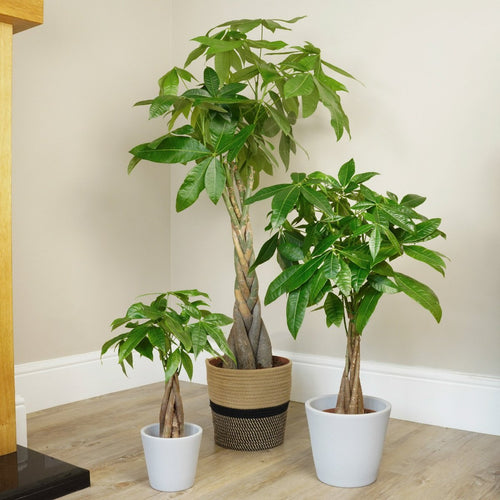
Money Tree
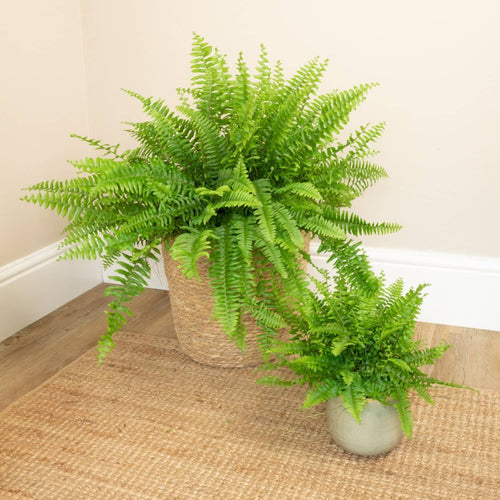
Boston Fern | Green Moment
Renown across the world for their distinct tropical appearance, air-purifying qualities, pet-friendly nature & low care requirements, these stunning Green Moment Boston Ferns (also known as the 'Nephrolepis Exaltata') are a delightful variety that is sure to inspire! Great for beginners and seasoned growers alike, these are fantastic for adding a natural decorative touch at home, in the office and beyond with their vibrant green fronds and captivating style. Immensely adaptable too, these can shine beautifully whether sitting on a table or hanging in a basket indoors or out. Please note decorative pots are sold separately.

Palm | Golden Queen
These striking 'Golden Queen' Dracaena Palms are a decorative delight, and are sure to inspire! They are best identified through their captivating green leaves with yellow margins sitting atop their tall trunks, and their air-purifying nature means that by caring for yours, it'll take care of you too! They are a must-have if you're looking to add a touch of tropical positivity to your spaces, and they look the part at home, in the office & beyond. Great for gifting too, they are ideal as a first houseplant due to their straight-forward and easy to master care needs!
Please note as a natural product, the plant you receive may vary to that shown in appearance, leaf/stem count and overall size. We always recommend going by your chosen variant's listed pot measurement and approximate 'overall' height for the best idea of how yours will look upon arrival. See our Size Guide above for further measurement guidance and decorative pot recommendations. Decorative pots sold separately.
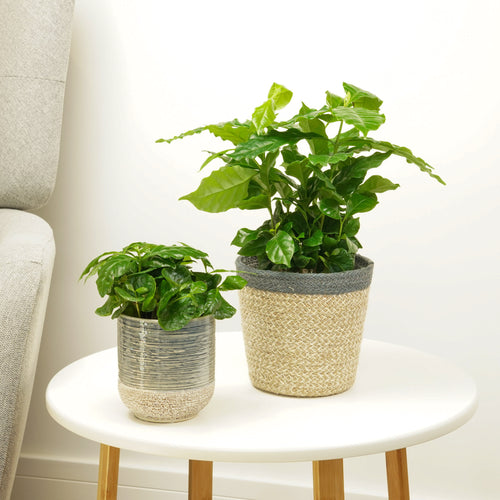
Coffee Plant | Arabica
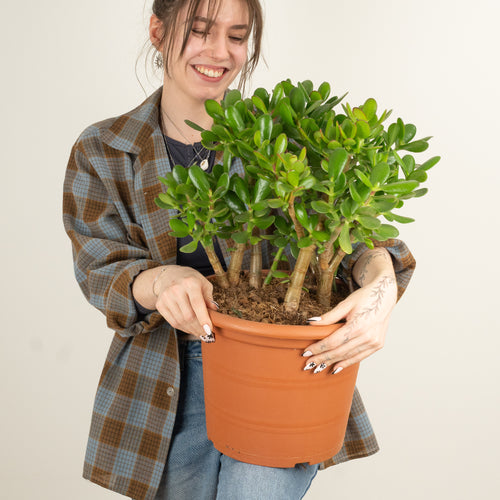
Jade Plant | Ovata
Cherished as a cultural staple in many countries, these stunning Jade Crassula 'Ovata' Money Plants are often given as gifts for special events and are said to share good fortune with those around them. They're perfect for both beginners and seasoned growers alike due to their low maintenance nature, and are ideal for adding a gentle, tropical touch at home, in the office and beyond. They can also help purify the surrounding air, so by caring for yours - it'll care for you too! There's plenty to love with these robust, succulent evergreen Jades and they are a must-have if you are looking to start, or expand upon, your indoor jungle.
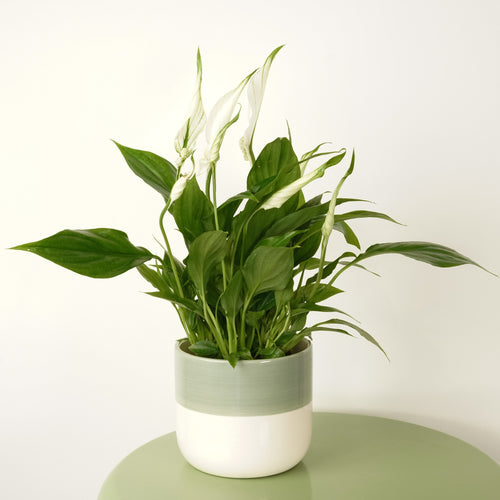
Peace Lily | Chopin
The 'Chopin' Peace lily is a bushy foliage plant that is easy to care for and low-maintenance. The peace lily makes the perfect indoor plant as it is a very easy going plant that re-flowers easily, producing slender white spathes that delicately sit proudly of the vivid green, sword shaped leaves. Botanically known as Spathiphyllum, this sweet plant originates from Central America and makes a delightful gift.
Please note as a natural product, the plant you receive may vary to that shown in appearance, leaf/stem count and overall size. We always recommend going by your chosen variant's listed pot measurement and approximate 'overall' height for the best idea of how yours will look upon arrival. See our Size Guide above for further measurement guidance and decorative pot recommendations. Decorative pots sold separately, terrarium variant includes 40cm glass container and 9cm pot Chopin.
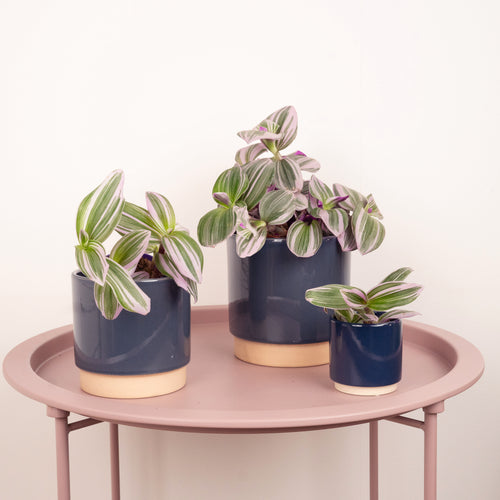
Wandering Dude Nanouk
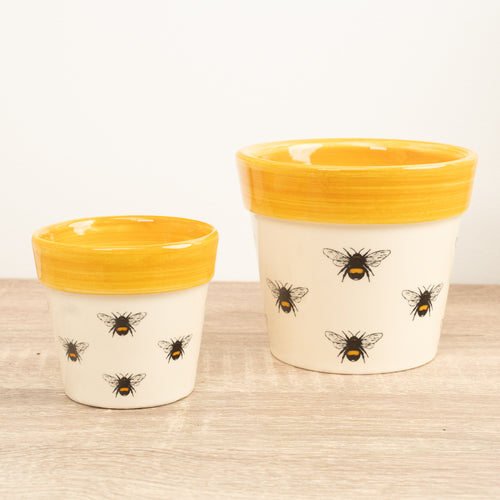
Bumble Bee Pot | Yellow
Don't worry, bee happy! If you're looking for a bright, positive pot that's sure to inspire and look great with your houseplants or patio plants, this ceramic yellow, white and black Bumble Bee Pot certainly makes for a superb pick! Perfect for all kinds of plant varieties, it's sure to spark joy with orchids, succulents, tropicals and beyond - plus makes for a thoughtful gift to someone who loves nature and needs a cosy pot to go with their plant!

Happy Easter Egg | Decorative Plant Pot Accessory
A lovely decorative 'Happy Easter' sign on a stick that can be placed with your plant for seasonal events or just to spruce it up year-round!

Happy Easter Sign | Decorative Plant Pot Accessory
A lovely decorative 'Happy Easter' sign on a stick that can be placed with your plant for seasonal events or just to spruce it up year-round!
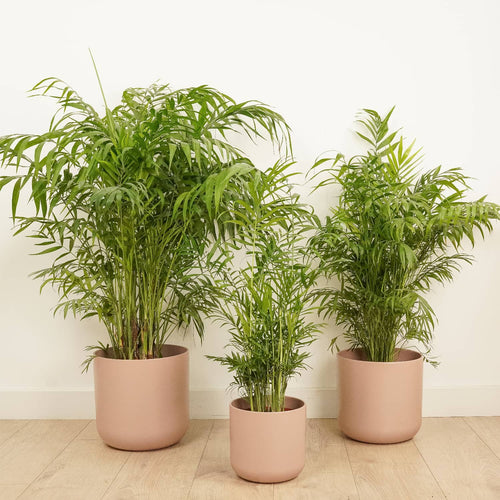
Parlour Palm
Interested in taking your decoration at home or in the workplace to the next level? These globally renown Chamaedorea Elegans plants - also known as Parlour Palms - are perfect for adding a natural, tropical touch wherever they go. They are low maintenance so fantastic for beginners, pet-friendly, and can even help purify the surrounding air - so by caring for yours, it'll care for you too! Brighten up your spaces today and enjoy some all-natural inspiration with a fresh new Parlour Palm.
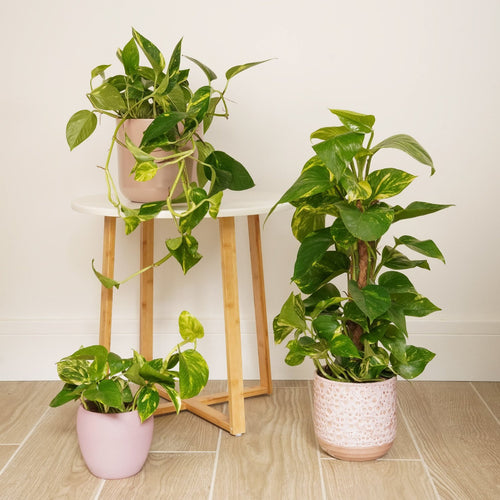
Devil's Ivy | Golden Pothos
With pretty variegated emerald-green and golden yellow leaves that give this plant a lost treasure look, it's no wonder that this Golden Pothos is a popular trailing plant. The stunning colour combination just radiates optimism and clarity - perfect for inspiration in both work and personal life. Due to the Devil's Ivy nature to grow long vines, this plant would look great on shelves or as a hanging plant.
Please note decorative pots are sold separately and your plant may vary naturally to that shown depending on size selected and growth variance. Each plant tends to be different, just like us! Looking for more Pothos plants? Click here!

Happy Easter Banner | Decorative Plant Pot Accessory
A lovely decorative 'Happy Easter' sign on a stick that can be placed with your plant for seasonal events or just to spruce it up year-round!

Happy Easter Pot | Metallic
Eggcellent for all of your Easter celebrations, these vibrant metallic pot are the perfect way to bring fun, happiness and eggcitement wherever they go! (okay, we'll stop with the egg puns now.) They possess a charming printed 'Happy Easter' design upon their exterior, and their strong, resilient nature makes them great for use in the long-term - being brought out year after year to brighten up your spaces!
Please note, whilst we aim for the colours in our product photographs to be as true-to-life as possible, minor variances can occur depending on computer screen settings. Pot shapes may also vary slightly, and sizes shown are based on their maximum suitable nursery pot. As such, a plant from our store with a 10cm nursery pot should fit comfortably in most ceramic/decorative pots at this size or beyond.

Yellow Egg Trio | Decorative Plant Pot Accessory
A lovely decorative yellow egg trio on a stick that can be placed with your plant for seasonal events or just to spruce it up year-round!
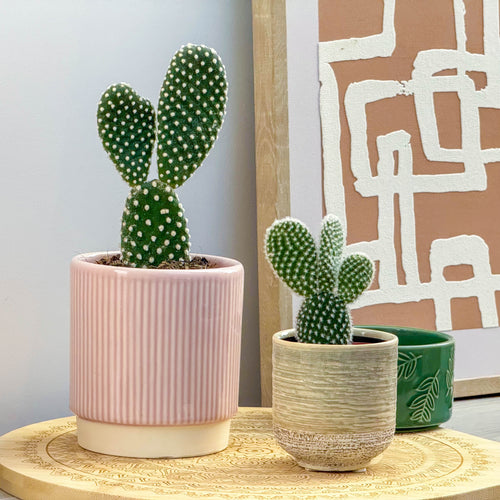
Bunny Ears Cactus
Native to Northern Mexico, this iconic Bunny Ears Cactus is widely known for its cute, captivating silhouette reminiscent of a rabbit's oval-shaped ears! It's a special low maintenance succulent so makes for a perfect companion when brightening up those less-travelled areas. It's also popular as a thoughtful gift to loved ones looking to grow their green thumb!
Please note, not all Bunnies have two ears! Some have one big ear whilst others may have three or four! You may also experience the odd dropped ear after transit, but rest assured, these can simply be replanted back into the soil to continue growing cheerfully. Decorative pots sold separately, handle with care.
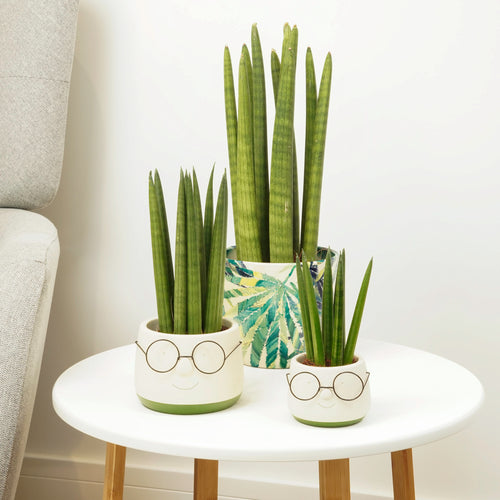
Snake Plant | Cylindrica
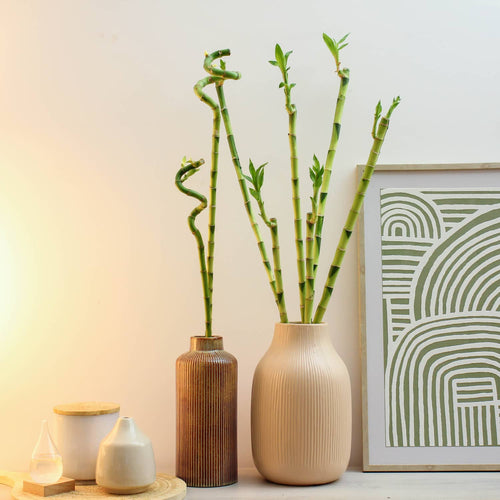
Lucky Bamboo
These magnificent Lucky Bamboo stems evoke incredible, exotic auras of tropical Asia and are undeniably captivating to the eye. Lucky Bamboo has been used for thousands of years in many parts of Asia as it is believed to bring good luck, prosperity and love to you or the person you share it with! It's also got a fascinating fact in that it's actually part of the Dracaena family! Use only rain water for your bamboo. You will receive x1 Lucky Bamboo stem. Fancy an upgrade? Try the Lucky Bamboo Trio arranged in glass, or select one of our Hurricane Vase displays for the ultimate décor upgrade.
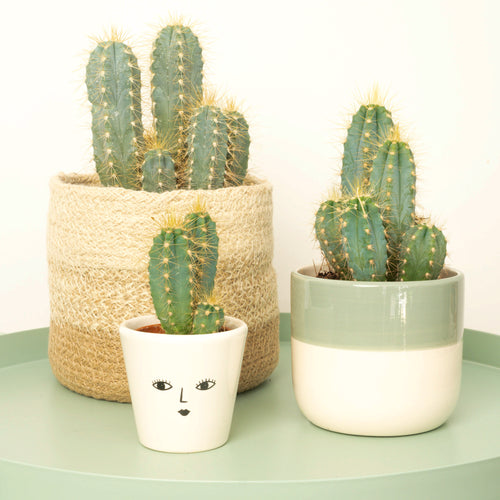
Blue Torch Cactus
This beautiful, rare and easy-care Pilosocereus Azureus, more commonly known as the Blue Torch Cactus, is a well admired, flowering succulent known for its unique blue-green complexion and traditional Cacti appearance. These fascinating tropical cacti have their origins in the vibrant lands of Brazil, the Caribbean and Mexico, so make for excellent decorative pieces and conversation starters. You'll also find that as they grow and age, their incredible blue colours enhance and improve!
Please note height and stem count can differ to that photographed depending on the variety selected and natural factors from plant-to-plant.
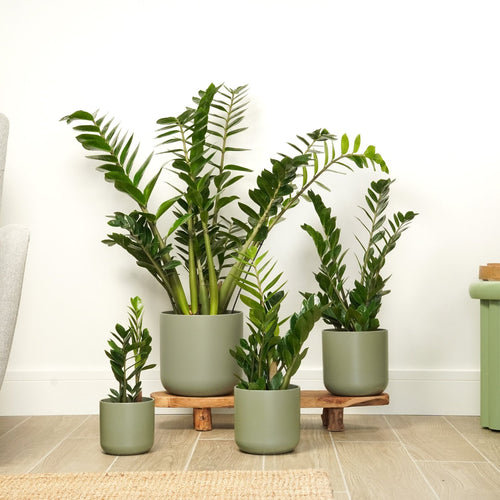
ZZ Plant
These stunning Zamioculcas Zamiifolia plants - commonly known as the ZZ - are a captivatingly beautiful variety admired for their beginner-friendly qualities, shade tolerance, air-purifying abilities, and distinctly tropical architectural style! They are perennial natives of Africa in the wild, and their vibrant silhouette makes them an ideal decorative companion whether in the office, at home, and beyond. They can inspire just about anywhere, and their easy care requirements makes them superb for gifting too!
Please note as a natural product, the plant you receive may vary to that shown in appearance, leaf/stem count and overall size. We always recommend going by your chosen variant's listed pot measurement and approximate 'overall' height for the best idea of how yours will look upon arrival. See our Size Guide above for further measurement guidance and decorative pot recommendations. Decorative pots sold separately.

